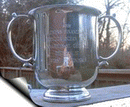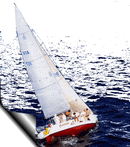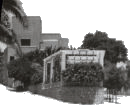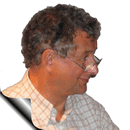
The 1995 Annapolis - the Azores (Horta) North Atlantic crossing on Hermès
Date: June 30, 1995 to July 17, 1995
Length: 2,210 nm
[Sail/photogallery/photo15652/real.htm]See More Hermès Photos but be patient, slow loading page with lots of large pictures!
Email send to Sail at WorldBank dot org
JUL95
@SAILors:
Those of you who read French may recall that in March, Bernard Montfort had
issued an Email (in French) to @SAIL, looking for a candidate to complete
his crew on Hermes, a 45' Jeanneau SunKiss, for the first leg of an Atlantic
crossing. I was fortunate to be selected and I am glad to report to you that
everything went well for the Annapolis-Horta (Azores) part.
The crew of 4 was complete on 6/28 and we left the morning of 6/30 with a good weather forecast (no "tropical" system of any kind in view) but far from perfect for the two Bays. We sailed and motored up the Chesapeake and spend the night in Chesapeake City, at the C&D canal entrance (the full marina and the shallow anchorage area made us move the boat at midnight to the fuel pump dock to avoid being stranded at low tide, even with the centerboard in the up position). We left before 5am with still unfavorable current (about 2h30 before tidal flow reversal) to motor through the canal and then down the Delaware Bay (see More Hermès Photos). Despite a SE head wind, we reached the Ocean off Cape May at 6pm just in time to avoid the full force of the raising tide. This northern exit is about 50 nautical miles (nm) shorter than the Chesapeake Bay exit but is more difficult for a sailboat, as 2+ knot tidal currents are common in both the canal and the tricky mouth of the Bay. Furthermore, anchoring places in Chesapeake City are shallow at low tide and the timing between the tides is too short for anything but powerboats to make the canal-bay mouth trip cleanly in one tide.
We then spend almost a full day heading SE to reach the Gulf Stream as soon as possible. At the end of the day, it was amazing that we could literally see the eddies created by conflicts between the cold Labrador current going South along the coast and the Gulf Stream. The next few days we tried to stay within the Gulf Stream to benefit from its 1+ knot boost but it took us several days to realize that the center line of the Gulf Stream is not stable and moves very rapidly North or South, creating giant 10-50 nm eddies at its edges. The position of the Gulf stream is updated from satellite pictures and given at the time of weather forecasts by NOOA but the Cap Over Ground, Speed Over Ground and Speed Made Good indications of the GPS were clearly showing us the strong sideways, frontal or rear currents. We then decided to follow the great circle route, i.e. the heading given to us by the GPS, which took us North of the 40th parallel.
We were expecting good speed early and the winds to die down near the Azores High, but we got the opposite. We suffered from several periods of light wind early in the passage (some accompanied by a nasty swell, which made the sails flap and prompted some sea sickness bouts), in which the light asymmetrical spinnaker did a splendid job, and we had good force 5 wind at the end, which produced two 170+ nm days. A nasty tropical storm crossed our path but we fortunately were already 600 nm away. One day a water spout (small tornado) started from a nearby cloud and came within 150 m of us (we had time to roll the genoa and drop the main and were ready to take cover in the cabin). We arrived at Horta (see More Hermès Photos) the night of July 17 (unfortunately in the 2 h period of darkness between sunset and moonrise) after 17 days of open seas and an average of 130+ nm/24h.
We sighted 7 commercial ships and asked 3 of them to relay messages to shore (see More Hermès Photos). None of these messages reached destination! We had the constant company of birds from start to end, which was a surprise, as at one point we were more than 400 nm away from the nearest land (Cape Race in Newfoundland or the Azores). We caught only 3 fish on our trolling line and the largest, a 15-20 pounds tuna escaped easily despite Bernard's spear gun, after it was reeled in too fast. Gray and spotted dolphins (see More Hermès Photos) kept us company regularly (one school had several small calves swimming along their mothers) and we sighted some turtles and several mid sized (15-25') dark whales with a long U-boat-shaped snout, slit like blowhole, which were indifferent to us (we had to maneuver to avoid the first couple). We called them erroneously "belugas". They were either small sperm whales or mammals of the blackfish family (I will have a better idea after I receive my photos from processing - see More Hermès Photos).
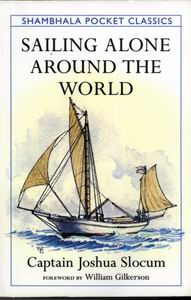 The marina at Horta is top class, the island of Faial is splendid and
full of friendly people. We arrived a few days before the 100th anniversary
of the arrival of Josua Slocum, in the first solo circumnavigation which
launched long distance (pleasure) sailing. Two of us did a very enjoyable
bicycle tour of Faial (about 60km). Picture a 3-volcano island, one peaking
at 1050 m and one having erupted in the 60's (the moon-like landscape there
is fantastic) with milk cows in small green fields edged by beautiful
hydrangeas. Worth the trip, said the Michelin guide very accurately (see
More Hermès Photos).
The marina at Horta is top class, the island of Faial is splendid and
full of friendly people. We arrived a few days before the 100th anniversary
of the arrival of Josua Slocum, in the first solo circumnavigation which
launched long distance (pleasure) sailing. Two of us did a very enjoyable
bicycle tour of Faial (about 60km). Picture a 3-volcano island, one peaking
at 1050 m and one having erupted in the 60's (the moon-like landscape there
is fantastic) with milk cows in small green fields edged by beautiful
hydrangeas. Worth the trip, said the Michelin guide very accurately (see
More Hermès Photos).
Hermes is a good seaworthy and sea friendly boat (one could easily sail it single-handed; we spend several nights either under spinnaker in 10-12 knots apparent wind or wing-and-wing with a poled-out genoa in stronger winds), well-equipped and well- maintained for long passages (large storage areas, large water and fuel tanks, full assortment of rough weather sails, a wind generator and an amazing autopilot). Bernard is now sailing with his new crew to the Gibraltar strait, Malaga, the Balearic islands and finally Marseille. He was expecting good wind and good fishing in the Atlantic part (we learned that the waters of the Gulf Stream are relatively poor!) and was a bit apprehensive about potential strong levanter (eastern wind) in the strait. He knows sailing inside out and has so much fun doing everything meticulously that, except for the safety of the 24h vigil we kept (2h each every 8h), he does not really need a crew.
Good wind.
Jaffar
SEP95
@SAILors:
A quick update.
This afternoon, I have talked to Bernard Montfort and he has informed me that the second leg of his Annapolis-Marseille crossing went well. They had good weather and very good fishing from the Azores to Gibraltar. In the Mediterranean sea, however, they had two brief but strong storms with force 9-10 winds and broke the wind generator.
Bernard will be in the Bank October 4-15, 1995 and would be available for a BBL with the WB Sail Club to answer questions and show pictures and perhaps some video extracts (the editing of the full video will not be completed at that time). Unfortunately, I will be on mission at that period. If enough of you indicate their interest to Nathalie Tavernier, she will relay the message to Bernard and, I am sure, she will find a suitable date and place for the BBL.
Jaffar
PS:- On my pictures (when compared to a whale's field guide), the whales appear to be sperm whales. On the movie, Bernard says they appear to be pilot whales!
- I forgot to mention in my earlier email that we had an EPIRB rescue buoy on board, which was an essential part of this serene crossing: a flip of the switch in case of emergency would have started a beacon, send an emergency signal to nearby ships, send an emergency signal to a dedicated satellite network and most importantly, would have given our exact location to rescue units.
This site was last updated 05/08/10
